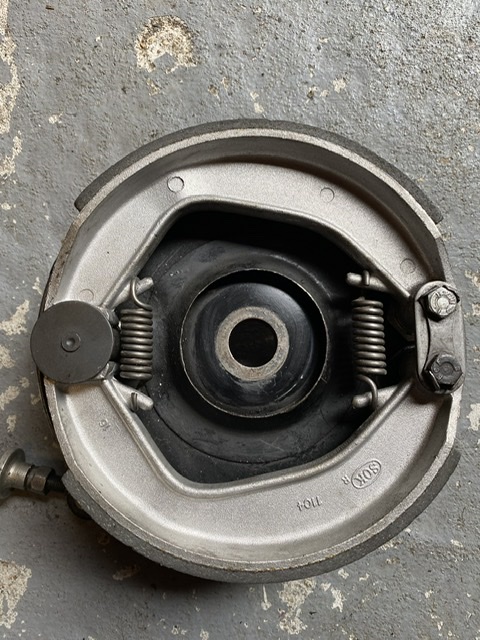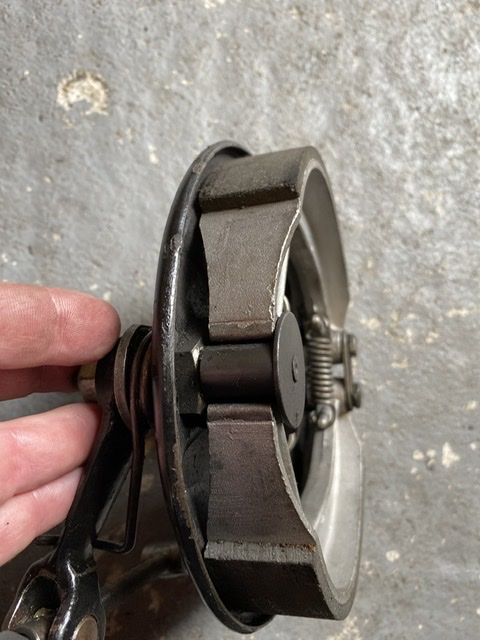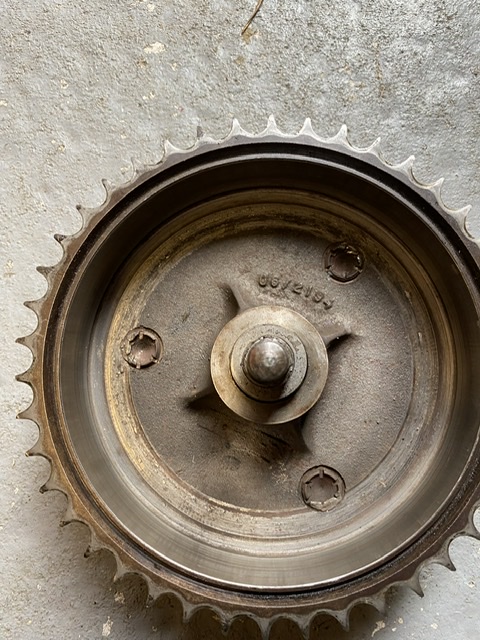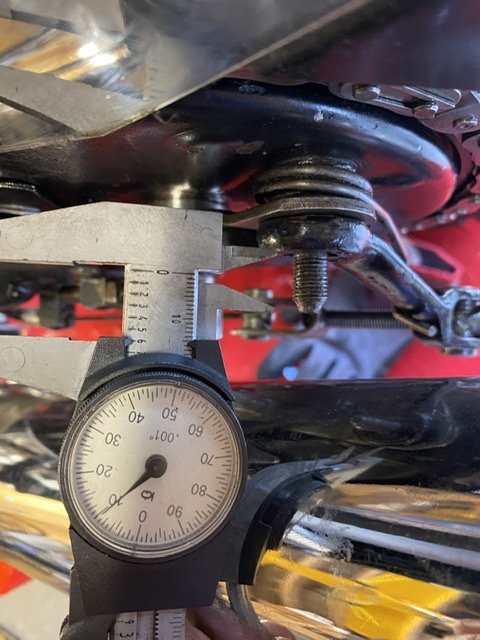I’ve been recommissioning a 1974 850 Mk2a Interstate. The bike hadn’t been used for a number of years so I’ve given it a thorough service and a good going over. With a break in the weather last we I took her out on the road for the first time. One thing I noticed was excessive movement of the rear brake pedal to get any effective braking (about 2.5”). Back in the workshop I adjusted the pedal to give a more reasonable amount of movement but then found the brake to be binding. It’s was as though the first half of the pedal movement put the brakes shoes into contact with the brake drum and then the second half of the movement applied the brakes proper.
I dismantled the brake drum/ sprocket and inspected the brakes. The shoes look nearly brand new and seem to operate correctly. Suspecting that the problem might be the brake drum bearing I dismantled the stub axle assembly and replaced the bearing. Upon reassembly I found it made no difference. I have also tried putting an additional spacer between the stub axle and the brake plate assembly - no change. What I have noticed is that if I reduce the torque on the rear axle nut opposite (other side of the wheel from the stub axle) then the binding disappears. Can anyone give me a clue as to what is going on please? Any suggestions welcome.
Regards to all
bike drum brakes have to be…
- Log in to post comments
Thanks Robert
I did that as a matter of course. I then repeated to double check; sadly didn’t change anything.
Thank you for your reply.
- Log in to post comments
Hi Richard, I'm thinking…
Hi Richard, I'm thinking there is definately something wrong in there, Can you post a photo of the shoes ,or compare them to a known to be correct set. Also a picture of the brake cam , its possible to install it 180 degees out , It still works but with lost leverage. I'm not familiar with Commando's but it also sounds as if your speedo drive could be dished /buckled , does it rub the alloy cover plate?. A bit of open mind detective work for you !!. I would not be riding it till the issue sorted. I can't think of a worse job than having to be taking the rear wheel in and out.Consider putting those shoes ( Indian fakes?) to one side and buying some new from RGM ( gold woven linings) , If the old shoes turn out to be genuine get Villiers Services to reline for your spares box.
- Log in to post comments
It sounds...
... as though when you tighten the RHS end of the spindle it's pulling everything across causing the binding. I would suggest a missing / wrong spacer. You do have the central tube spacer between the bearings fitted don't you? This would cause a similar problem if not in place.
- Log in to post comments
Thank you both….
After reading your comments I dismantled the rear again. 
 The attached photos show the shoes and cam which look ok to me.
The attached photos show the shoes and cam which look ok to me.
Following your suggestion Ian I looked at the wheel to check the spacer was in place - it was. I then spent a rainy afternoon in my shed swapping parts in from my other Commando. Swapping out the wheel, spindle and speedo drive made no difference. However, swapping the brake drum/stub axle assembly did.
When recommissioning the bike I did notice significant score marks on the inside of the drum. Since there were no witness marks on the brakes shoes themselves I assumed that the PO hadn’t fitted enough shims between the stub axle and the brake plate at some point in the past.

I’m now thinking that either the drum itself or the stub axle is the problem…
Thank you again.
- Log in to post comments
What shims?
Hi Richard. In your last post you said that the PO hadn't fitted enough shims between the stub axle and the brake plate. I didnt know it was supposed to be shimmed out here. I changed my sprocket/drum recently. The old one was scored like yours but 10 times worse and when I reassembled the new one the bolt heads which hold the shoes on still caught on the rivets on the inside of the drum so I filled the heads down very slightly. Should I have put shims somewhere instead? I've never seen shims on any schematics. Have a look at the picture attached...what a mess!
- Log in to post comments
Hi Graham,
At the risk of the blind leading the blind, to quote Norman White “Check when the brake plate is installed into the drum that the two 1/4” screws clear the rear of the drum when rotated. If there is any contact then assemble one or more shims ( part no. 06 7603) to the dummy axle.”
The gouging in your drum, similar to mine, is caused by the heads of the two screws/bolts, that secure the “fixed” end of the brake shoes, making contact with the drum. Putting one or more shims between the axle and brake plate increases the clearance to avoid the problem. You don’t want to use more than necessary though otherwise you open the gap between the rim of the brake plate and the drum making contamination of the brake shoes more likely.
- Log in to post comments
Not being a Commando owner …
Not being a Commando owner ,I don't know about shims. Its possible that the drum is dimensionally incorrect, there has been some poor pattern stuff. I know some of the linings on pattern shoes are completely useless despite "classic" branding, stick to RGM or similar. I have had to file off the edges of shoes/linings for clearance to the back of drum. Chain alignment could be an issue too looking at wear pattern. Looks possible for shoes to be bearing on ledge worn in back of drum.
- Log in to post comments
Good point
I don’t know the history of the brake shoes so they may or may not be any good. I am travelling the next few days but when I get back I plan to try fitting the brake plate assembly from my known good machine in combination with the Mk2a drum and see if the binding problem returns. I guess I will then have my answer as to whether it is the drum or not.
Richard, I take your point about the wear so I will replace the drum/sprocket anyway but I would like to confirm the drum is the issue first.
Thank you again everyone for your comments and suggestions. Always appreciated and one of the great benefits of our club.
- Log in to post comments
Thanks too
Sorry for nearly hijacking this thread but thanks Richard P for that much needed info and part numbers. Its always bugged me that something isn't as it should be, so it's great to know that this is how it is sometimes, especially as it's brakes, and that there's a fix. Cheers!
- Log in to post comments
More on 2A rear brakes
I have had my rear drum off and replaced shoes (RGM) recently on my Mk2A.
I have reassembled everything, only to find the brake was reluctant to come off all the way. I have actually seldom used the rear brake as the pedal movement has always been too far in my opinion, so this has probably been the case for ever on this bike! I have since discovered that RGM list a return spring for the Commando brake pedal, which my bike has never had, which I have ordered and expect the problem to be cured - as a gentle lift of the brake pedal by hand is enough to get the brake arm back to its full release position - just as though the brake arm return spring isn't quite strong enough to do the job on its own?
Whilst investigating this issue however I noticed that tightening the brake arm to its shaft ultimately tightened the arm against the brake stay arm - therefore preventing any motion of the arm? The problem is that the flats on the brake cam shaft don't appear to extend far enough to allow the arm to be tightened fully against the end of the flat portion without gripping the brake torque arm as well?
The brake cam was not disturbed when I changed the shoes, so it's been as is for the last 40 years to my sure knowledge. The manual lists a "bearing /spacer" between the swing arm and the brake backplate, but I only appear to have a chrome spacer? Could this be too long?
- Log in to post comments
After reading your email David…
I thought I would do a little experiment. The lever return spring works in concert with the two brake shoe return springs. The lever spring is pretty weak; the springs on the shoes are very strong, so I wondered if the lever would return to its neutral position if the lever return spring were removed. The answer is no! With the return spring disconnected the brake shoes pull back from the drum but the lever doesn’t quite return to neutral without the additional assistance.
To your point about the cam shaft I removed the nut that secures the brake lever to the brake cam shaft and measured the length of shaft/thread protruding through the lever.

As you can see it was a shade over 0.6”. No sure if this helps you but when I tighten the nut to the recommended 30ft lbs mine moves freely.
- Log in to post comments
Tim Stevens...
... in the Commando Service Notes recommended cutting up a moped inner tube to act as backup / helper for the pedal return spring.
- Log in to post comments
The main purpose of the…
The main purpose of the spring for the brake pedal pivot was that in the event of a failure of the spring on the brake backplate the pedal spring would prevent the pedal dropping and acting as a pogo stick (edit - or perhaps I should have said like the pole of a pole vaulter) with potentially disastrous results. I seem to remember a police rider losing his life because of this happening.
- Log in to post comments
Thank you for your comments…
Thank you for your comments. I also remember the brake pedal pogo stick story! There never being a moped rider around when you want one I have made do with a bunjee cord and the brake arm now returns to its stop. Success! As to the arm binding on the torque arm, I stripped the whole thing down again and found the large nut which attaches the tube to the backplate was loose to the extent that I got over a turn on the thing without difficulty! The result is a brake arm which no longer binds on the torque arm because the cam bolt can now extend far enough through the backplate. Now it all works perfectly. I can honestly say that in just over 40 years of ownership , this is only the second occasion I have felt the need to remove the rear drum - although this "occasion" was actually four times....Now it all works I shall certainly be using the rear brake more in future. Thanks again.
- Log in to post comments
Pleased to hear that all is…
Pleased to hear that all is well but recommend getting the pedal safety spring.
- Log in to post comments




bike drum brakes have to be centralised and some play in the assembly is incorporated to allow this . It’s usual to slacken the axle nut on the brake side, apply the brake hard and tighten up while holding the brake on .